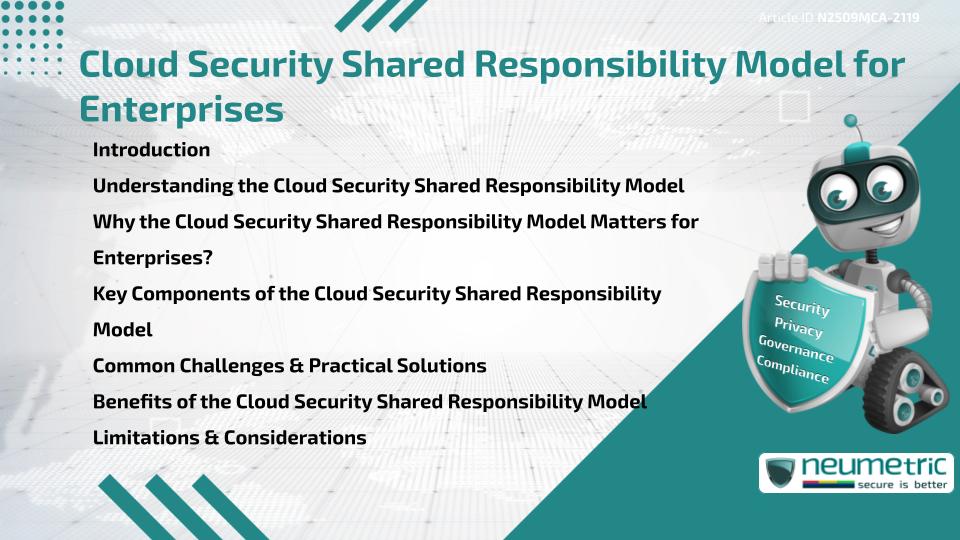Table of Contents
ToggleIntroduction
The Cloud Security Shared Responsibility Model is a Foundational Principle that defines How Cloud Providers & Customers divide Accountability for protecting Data, Applications & Infrastructure. For Enterprises adopting Public, Private or Hybrid Cloud Environments, understanding this Model is critical to reducing Security Risks, ensuring Compliance & Maintaining Trust with Stakeholders.
Understanding the Cloud Security Shared Responsibility Model
The Cloud Security Shared Responsibility Model clarifies which Security Tasks are managed by the Cloud Provider & Which remain with the Enterprise. Typically, Providers secure the underlying Infrastructure, while Customers are responsible for securing Data, Identities & Applications running in the Cloud.
For more background, see the NIST Cloud computing guidance.
Why the Cloud Security Shared Responsibility Model Matters for Enterprises?
Misunderstanding responsibilities is one of the leading causes of Cloud Data Breaches. Enterprises often assume Providers handle all aspects of Security, leaving Critical Gaps. The Cloud Security Shared Responsibility Model matters because it:
- Clarifies Security Ownership across different Cloud Service types (IaaS, PaaS, SaaS).
- Reduces Compliance Risks under Frameworks like ISO 27001, PCI DSS & HIPAA.
- Ensures better alignment between Security Teams & Providers.
- Builds trust with Regulators, Partners & Customers.
The Cloud Security Alliance provides useful frameworks for implementing Shared Responsibility.
Key Components of the Cloud Security Shared Responsibility Model
- Infrastructure Security – Providers secure Physical Data Centres, Networks & Host Systems.
- Platform & Application Security – Shared between Provider & Enterprise depending on Service Model.
- Data Security & Privacy – Enterprises must Encrypt, Classify & Monitor their own Data.
- Identity & Access Management – Customers retain Responsibility for managing User Accounts & Permissions.
- Compliance Alignment – Both parties must meet relevant Legal & Industry requirements.
- Monitoring & Incident Response – Providers manage core Infrastructure monitoring, while Enterprises must handle Application-level Incidents.
The ENISA Cloud Security guidelines explain these elements in detail.
Common Challenges & Practical Solutions
- Role Confusion – Conduct clear reviews of Provider contracts to Define Responsibilities.
- Multi-Cloud Complexity – Use Governance Frameworks to manage differences across Providers.
- Skill Gaps – Train Staff to understand their Responsibilities under the Model.
- Visibility Limitations – Deploy Cloud Monitoring Tools for Real-time Oversight.
The NCSC UK Cloud principles offer guidance on addressing these challenges.
Benefits of the Cloud Security Shared Responsibility Model
- Reduced Risk of Breaches – Clarifies Accountability & Prevents Security Gaps.
- Regulatory Assurance – Simplifies Compliance with Data Protection Laws.
- Operational Clarity – Ensures Teams know their exact Responsibilities.
- Enhanced Trust – Builds stronger relationships with Customers & Partners.
Limitations & Considerations
The Cloud Security Shared Responsibility Model does not eliminate Risks. Enterprises must adapt it to specific Providers & Services, update Policies regularly & avoid Over-reliance on Provider assurances without Verification.
Takeaways
- The Cloud Security Shared Responsibility Model defines How Providers & Enterprises divide Security Roles.
- It reduces Risks, ensures Compliance & improves Operational clarity.
- Success depends on understanding service Models & Maintaining strong Governance.
FAQ
What is the Cloud Security Shared Responsibility Model?
It is a Framework that defines Security obligations between Cloud Providers & their Customers.
Why is it important for Enterprises?
It reduces Security Gaps, supports Compliance & Builds Customer Trust.
Does the Model apply to all Cloud Services?
Yes, but responsibilities differ between IaaS, PaaS & SaaS Models.
Who manages Data Security under the Model?
The enterprise is Primarily responsible for securing its own Data.
How can organisations avoid confusion?
By reviewing Contracts, Training Staff & using Monitoring Tools.
References
- NIST – Cloud Computing Guidance
- Cloud Security Alliance
- ENISA – Cloud Security Guidelines
- NCSC UK – Cloud Principles
- IT Governance – Cloud Security
Need help for Security, Privacy, Governance & VAPT?
Neumetric provides organisations the necessary help to achieve their CyberSecurity, Compliance, Governance, Privacy, Certifications & Pentesting needs.
Organisations & Businesses, specifically those which provide SaaS & AI Solutions in the Fintech, BFSI & other regulated sectors, usually need a CyberSecurity Partner for meeting & maintaining the ongoing Security & Privacy needs & requirements of their Enterprise Clients & Privacy conscious Customers.
SOC 2, ISO 27001, ISO 42001, NIST, HIPAA, HECVAT, EU GDPR are some of the Frameworks that are served by Fusion – a SaaS, multimodular, multitenant, centralised, automated, CyberSecurity & Compliance Management system.
Neumetric also provides Expert Services for technical Security which covers VAPT for Web Applications, APIs, iOS & Android Mobile Apps, Security Testing for AWS & other Cloud Environments & Cloud Infrastructure & other similar scopes.
Reach out to us by Email or filling out the Contact Form…


